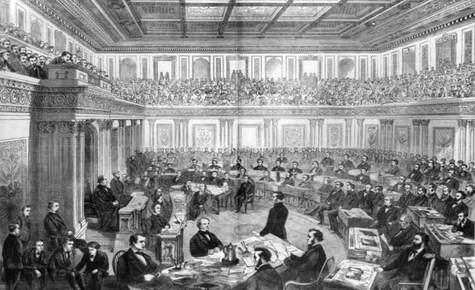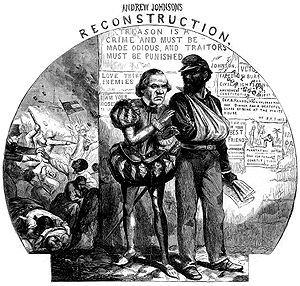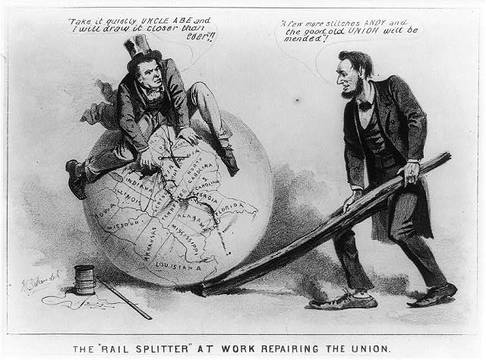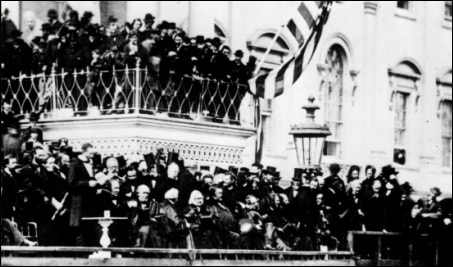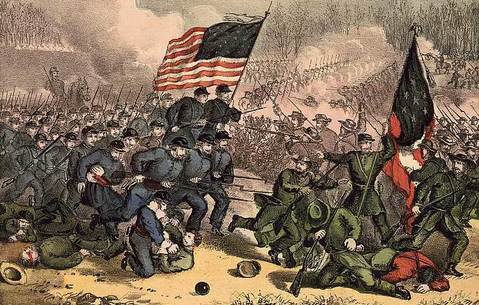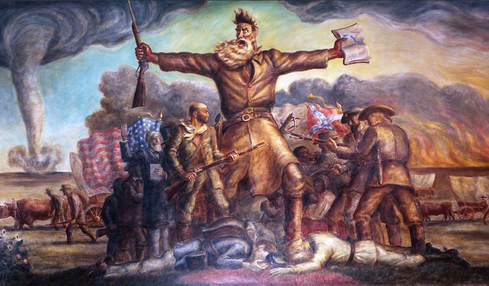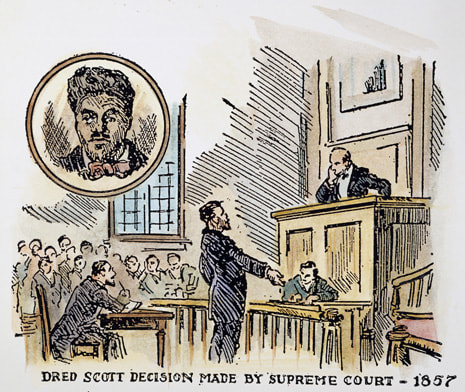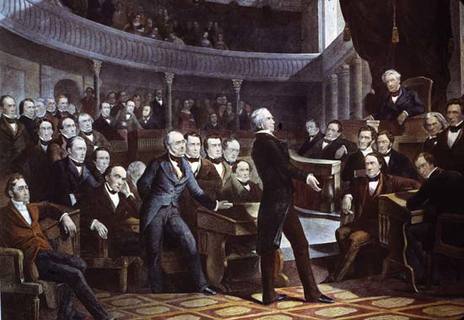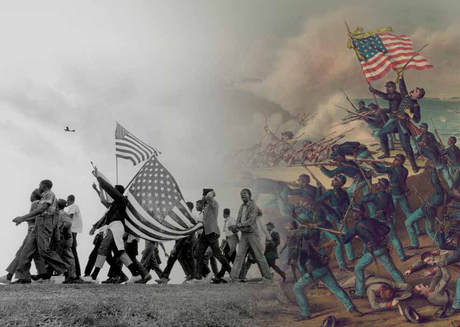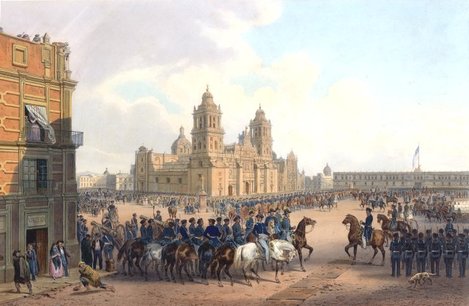|
Learning Target:
I can compare the differing approaches to Reconstruction, & I can assess its effects on the nation. Critical Vocabulary: Lincoln’s Second Inaugural Address, Ten Percent Plan, Wade-Davis Bill, Thirteenth Amendment, Freedmen’s Bureau, John Wilkes Booth, Andrew Johnson, Presidential Reconstruction Plan, Black Codes, Sharecropping, Debt Peonage, Radical Republicans, Thaddeus Stephens, Charles Sumner, Joint Committee on Reconstruction, Congressional Reconstruction Plan, Civil Rights Bill of 1866, Fourteenth Amendment, “Swing Around the Circle” Tour, “Waving the Bloody Shirt,” Reconstruction Acts, Tenure of Office Act, Impeachment, Scalawags, Carpetbaggers, 1868 Presidential Election, Ulysses Grant, Fifteenth Amendment, Ku Klux Klan, Enforcement Acts, Amnesty Act, Election of 1876, Rutherford B. Hayes, Samuel Tilden, Compromise of 1877, Redeemers, Lost Cause, Old South, Henry Grady, Poll Tax, Literacy Test, Grandfather Clause, Jim Crow Laws, Lynching, Plessy v. Ferguson Today's Agenda:
Homework: The Trials of Reconstruction Tentative Test Date: Week of December 11
0 Comments
Learning Target:
I can compare the differing approaches to Reconstruction, & I can assess its effects on the nation. Critical Vocabulary: Lincoln’s Second Inaugural Address, Ten Percent Plan, Wade-Davis Bill, Thirteenth Amendment, Freedmen’s Bureau, John Wilkes Booth, Andrew Johnson, Presidential Reconstruction Plan, Black Codes, Sharecropping, Debt Peonage, Radical Republicans, Thaddeus Stephens, Charles Sumner, Joint Committee on Reconstruction, Congressional Reconstruction Plan, Civil Rights Bill of 1866, Fourteenth Amendment, “Swing Around the Circle” Tour, “Waving the Bloody Shirt,” Reconstruction Acts, Tenure of Office Act, Impeachment, Scalawags, Carpetbaggers, 1868 Presidential Election, Ulysses Grant, Fifteenth Amendment, Ku Klux Klan, Enforcement Acts, Amnesty Act, Election of 1876, Rutherford B. Hayes, Samuel Tilden, Compromise of 1877, Redeemers, Lost Cause, Old South, Henry Grady, Poll Tax, Literacy Test, Grandfather Clause, Jim Crow Laws, Lynching, Plessy v. Ferguson Today's Agenda:
Homework: The Trials of Reconstruction Tentative Test Date: Week of December 11 Learning Target:
I can compare the differing approaches to Reconstruction, & I can assess its effects on the nation. Critical Vocabulary: Lincoln’s Second Inaugural Address, Ten Percent Plan, Wade-Davis Bill, Thirteenth Amendment, Freedmen’s Bureau, John Wilkes Booth, Andrew Johnson, Presidential Reconstruction Plan, Black Codes, Sharecropping, Debt Peonage, Radical Republicans, Thaddeus Stephens, Charles Sumner, Joint Committee on Reconstruction, Congressional Reconstruction Plan, Civil Rights Bill of 1866, Fourteenth Amendment, “Swing Around the Circle” Tour, “Waving the Bloody Shirt,” Reconstruction Acts, Tenure of Office Act, Impeachment, Scalawags, Carpetbaggers, 1868 Presidential Election, Ulysses Grant, Fifteenth Amendment, Ku Klux Klan, Enforcement Acts, Amnesty Act, Election of 1876, Rutherford B. Hayes, Samuel Tilden, Compromise of 1877, Redeemers, Lost Cause, Old South, Henry Grady, Poll Tax, Literacy Test, Grandfather Clause, Jim Crow Laws, Lynching, Plessy v. Ferguson Today's Agenda:
Tentative Test Date: Week of December 11 Learning Target:
I can compare the differing approaches to Reconstruction, & I can assess its effects on the nation. Critical Vocabulary: Lincoln’s Second Inaugural Address, Ten Percent Plan, Wade-Davis Bill, Thirteenth Amendment, Freedmen’s Bureau, John Wilkes Booth, Andrew Johnson, Presidential Reconstruction Plan, Black Codes, Sharecropping, Debt Peonage, Radical Republicans, Thaddeus Stephens, Charles Sumner, Joint Committee on Reconstruction, Congressional Reconstruction Plan, Civil Rights Bill of 1866, Fourteenth Amendment, “Swing Around the Circle” Tour, “Waving the Bloody Shirt,” Reconstruction Acts, Tenure of Office Act, Impeachment, Scalawags, Carpetbaggers, 1868 Presidential Election, Ulysses Grant, Fifteenth Amendment, Ku Klux Klan, Enforcement Acts, Amnesty Act, Election of 1876, Rutherford B. Hayes, Samuel Tilden, Compromise of 1877, Redeemers, Lost Cause, Old South, Henry Grady, Poll Tax, Literacy Test, Grandfather Clause, Jim Crow Laws, Lynching, Plessy v. Ferguson Today's Agenda:
Homework: The Trials of Reconstruction Tentative Test Date: December 11 Learning Target:
I can discuss the key military and political turning points of the Civil War. Critical Vocabulary: Nat Turner’s Rebellion, Underground Railroad, Harriett Tubman, “Fire-Eaters,” Stephen A. Douglas, Compromise of 1850, Fugitive Slave Act, Harriet Beecher Stowe, Uncle Tom’s Cabin, Ostend Manifesto, Kansas-Nebraska Act, New England Emigrant Aid Company, “Bleeding Kansas,” Republican Party, Dred Scott Decision, Abraham Lincoln, Freeport Doctrine, John Brown, Pottawatomie Creek, Lecompton Constitution, Harpers Ferry, Constitutional Union Party, Election of 1860, Crittenden Compromise, Confederate States of America, Jefferson Davis, First Inaugural Address, Fort Sumter Today's Agenda:
Homework: The Civil War Tentative Test Date: December 11 Learning Target:
I can summarize the events that led to the Civil War, & I can evaluate the degree to which each contributed to the conflict. Critical Vocabulary: Nat Turner’s Rebellion, Underground Railroad, Harriett Tubman, “Fire-Eaters,” Stephen A. Douglas, Compromise of 1850, Fugitive Slave Act, Harriet Beecher Stowe, Uncle Tom’s Cabin, Ostend Manifesto, Kansas-Nebraska Act, New England Emigrant Aid Company, “Bleeding Kansas,” Republican Party, Dred Scott Decision, Abraham Lincoln, Freeport Doctrine, John Brown, Pottawatomie Creek, Lecompton Constitution, Harpers Ferry, Constitutional Union Party, Election of 1860, Crittenden Compromise, Confederate States of America, Jefferson Davis, First Inaugural Address, Fort Sumter Today's Agenda:
Homework: On the Brink of War Tentative Test Date: December 11 Learning Target:
I can summarize the events that led to the Civil War, & I can evaluate the degree to which each contributed to the conflict. Critical Vocabulary: Nat Turner’s Rebellion, Underground Railroad, Harriett Tubman, “Fire-Eaters,” Stephen A. Douglas, Compromise of 1850, Fugitive Slave Act, Harriet Beecher Stowe, Uncle Tom’s Cabin, Ostend Manifesto, Kansas-Nebraska Act, New England Emigrant Aid Company, “Bleeding Kansas,” Republican Party, Dred Scott Decision, Abraham Lincoln, Freeport Doctrine, John Brown, Pottawatomie Creek, Lecompton Constitution, Harpers Ferry, Constitutional Union Party, Election of 1860, Crittenden Compromise, Confederate States of America, Jefferson Davis, First Inaugural Address, Fort Sumter Today's Agenda:
Homework: On the Brink of War Tentative Test Date: December 11 Learning Target:
I can summarize the events that led to the Civil War, & I can evaluate the degree to which each contributed to the conflict. Critical Vocabulary: Nat Turner’s Rebellion, Underground Railroad, Harriett Tubman, “Fire-Eaters,” Stephen A. Douglas, Compromise of 1850, Fugitive Slave Act, Harriet Beecher Stowe, Uncle Tom’s Cabin, Ostend Manifesto, Kansas-Nebraska Act, New England Emigrant Aid Company, “Bleeding Kansas,” Republican Party, Dred Scott Decision, Abraham Lincoln, Freeport Doctrine, John Brown, Pottawatomie Creek, Lecompton Constitution, Harpers Ferry, Constitutional Union Party, Election of 1860, Crittenden Compromise, Confederate States of America, Jefferson Davis, First Inaugural Address, Fort Sumter Today's Agenda:
Homework: On the Brink of War Tentative Test Date: December 11 Learning Target:
I can summarize the events that led to the Civil War, & I can evaluate the degree to which each contributed to the conflict. Critical Vocabulary: Nat Turner’s Rebellion, Underground Railroad, Harriett Tubman, “Fire-Eaters,” Stephen A. Douglas, Compromise of 1850, Fugitive Slave Act, Harriet Beecher Stowe, Uncle Tom’s Cabin, Ostend Manifesto, Kansas-Nebraska Act, New England Emigrant Aid Company, “Bleeding Kansas,” Republican Party, Dred Scott Decision, Abraham Lincoln, Freeport Doctrine, John Brown, Pottawatomie Creek, Lecompton Constitution, Harpers Ferry, Constitutional Union Party, Election of 1860, Crittenden Compromise, Confederate States of America, Jefferson Davis, First Inaugural Address, Fort Sumter Today's Agenda:
Homework: Manifest Destiny Tentative Test Date: December 11 Learning Target:
I can evaluate the extent to which the nineteenth century belief in “Manifest Destiny” led to the growing sectional conflict in the United States. Critical Vocabulary: Manifest Destiny, President James K. Polk, Oregon Territory, Treaty of 1818, Oregon Trail, Oregon Treaty of 1846, Stephen F. Austin, Antonio Lopez de Santa Anna, Texas Revolution, Battle of the Alamo, Goliad Campaign, General Sam Houston, Battle of San Jacinto, Election of 1844, James K. Polk, John Slidell, John C. Frémont, General Zachary Taylor, Mexican American War, “Spot Resolutions,” “Civil Disobedience,” Battle of Buena Vista, “Bear Flag Revolt,” General Winfield Scott, Treaty of Guadalupe-Hidalgo, Wilmot Proviso, “Popular Sovereignty,” Lewis Cass Today's Agenda:
Homework: Manifest Destiny Tentative Test Date: December 11 |
History, although sometimes made up of the few acts of the great, is more often shaped by the many acts of the small.
-Mark Twain AnnouncementsMay 4: No School ResourcesArchives
May 2018
Visitors |
